French physicist receives Niels Bohr Gold Medal
The prominent French physicist Alain Aspect received the Niels Bohr Gold Medal today. The medal will be presented at an event at the Honorary Residence at the Carlsberg Academy in Copenhagen to be attended by Her Majesty Queen Margrethe II and His Royal Highness Prince Henrik.
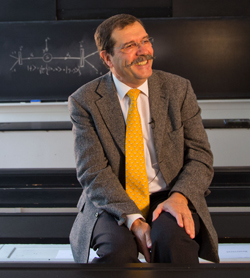
On the occasion of the 100th anniversary of Niels Bohr’s pioneering atomic model, the Danish Society of Engineers – in collaboration with the Niels Bohr Institute and the Royal Danish Academy of Sciences and letters – awards the Niels Bohr Medal to the prominent French physicist, Alain Aspect. Alain Aspect is here seen in the historical Auditorium A, where Niels Bohr held his lectures and met with the most outstanding physicist in the world.
The French physicist, Professor Alain Aspect has been awarded the Niels Bohr Gold Medal for his groundbreaking experiments in atomic physics and quantum optics. The experiments settled the legendary battle between Bohr and Einstein over the basic understanding of atomic physics by demonstrating the fascinating phenomenon of entanglement, which is the basis for the study of quantum information.
Exemplary experiments
Alain Aspect is the Augustin Fresnel Professor and a CNRS researcher (Centre National de la Recherche Scientifique) at the Institut d'Optique and a professor at Ecole Polytechnique – an impressive string of titles, reflecting an equally impressive number of achievements in his field of research.
“Alain Aspect is extremely skilled in his field, which is experiments with ultracold atoms and quantum optics. His experiments are exemplary. He knows how to play on the theoretical piano and devise just the right quantum optical experiments that focus penetratingly on a question and illuminate it from different sides, clarifying the problem,” explains Jörg Helge Müller, a quantum physicist at the Niels Bohr Institute.
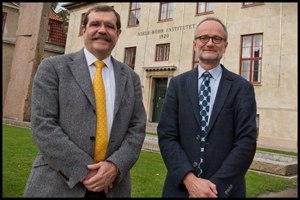
Alain Aspect is met by Professor Robert Feidenhans', director of the Niels Bohr Institute.
Important experiment in the history of science
The problem that Alain Aspect is particularly famous for having clarified is the legendary dispute between Albert Einstein and Niels Bohr concerning their views about quantum mechanics and the phenomenon of entanglement. Niels Bohr worked out quantum mechanics in the 1920s, which broke with the fundamental concepts of classical physics that an atoms state is only dependent on what you do with it locally – this is called local realism.
In contrast, Bohr’s description of quantum mechanics said that atomic particles had properties like spin, i.e. they could turn either left or right, but you can only provide a certain probability for which way they turn and as soon as they are measured, they change. In addition, the particles can stick together (be entangled), so even if they are removed from each other, they will still be able to ‘feel’ each other and react to an action on the other.
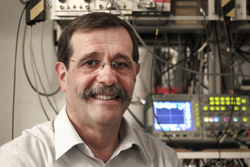
The recipient of the Niels Bohr Medal is the 65 year old French physicist and scientist Alain Aspect, who is known as an outstanding research in optical atomic physics.
Einstein did not like quantum mechanics, because it seemed random and ‘spooky’. Einstein maintained that quantum mechanics was an incomplete theory because of its lack of local realism. In 1964, this paradox was formalized by John Bell, who showed that the theory of local realism leads to a certain mathematical inequality – the so-called Bell’s inequality - which must be satisfied.
Aspect’s experiments
Aspect performed a series of experiments that convincingly demonstrated that the requirements expressed in the so-called Bell’s inequality did not apply, which confirmed Bohr’s position.
The experiments took place in 1982 and are known as the Aspect’s experiments. In Aspect’s experiments, they measured two particles that were released at the same time and from the same source in opposite directions. The results were conclusive proof of the fascinating phenomenon of entanglement, which is the basis for research into quantum mechanics information.
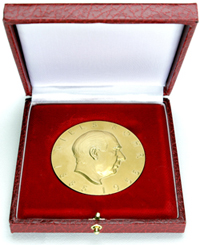
The Niels Bohr Gold Medal is made of the purest gold. It is 6.5 cm in diameter and weighs 500 g.
The Aspect experiments are fundamental to physics and our understanding of how the world is interconnected. But the research is not standing still. Alain Aspect is still working on cutting edge research and he is currently studying the localization of waves in solids using ultracold atoms. The research could test ideas from condensed matter physics in a whole new way and help improve the theoretical models. This approach in which experiments lead to advances in other branches of physics is characteristic of Alain Aspect’s work.
Prestigious award in distinguished company
The Niels Bohr Medal is an international award, which was established by the Danish Society of Engineers in 1955 in connection with Niels Bohr’s 70th birthday. The award aims to honour a scientist or engineer who has made a significant contribution to the peaceful use of nuclear energy. It was awarded 10 times between its inception and 1982 – usually to basic research in atomic physics.
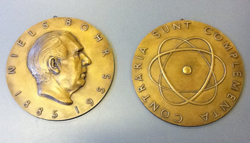
The front of the medal depicts Niels Bohr, and it says: Niels Bohr 1885 – 1955. This was in celebration of his 70th birthday, when he received the first medal. The back depicts Niels Bohr’s atomic model and also has his motto: Contraria sunt complementa (Opposites are complementary). The coin was made by a Harold Salomon, who was a medalist and sculptor at the Royal Danish Mint.
On the occasion of the 100th anniversary of Niels Bohr’s pioneering atomic model, the Danish Society of Engineers – in collaboration with the Niels Bohr Institute and the Royal Danish Academy of Sciences and Letters – again awards the Niels Bohr Medal to an internationally recognized active researcher whose work is related to the work of Niels Bohr.
The 2013 recipient of the Niels Bohr Medal, Alain Aspect, is described as a great personality with proven leadership abilities. In addition to his research, Alain Aspect is known as an excellent lecturer and his research group has for many years played host to promising young researchers from the United States and Europe, including Denmark.
The Niels Bohr Gold Medal
Aspect’s experiments
|
Entanglement
|
